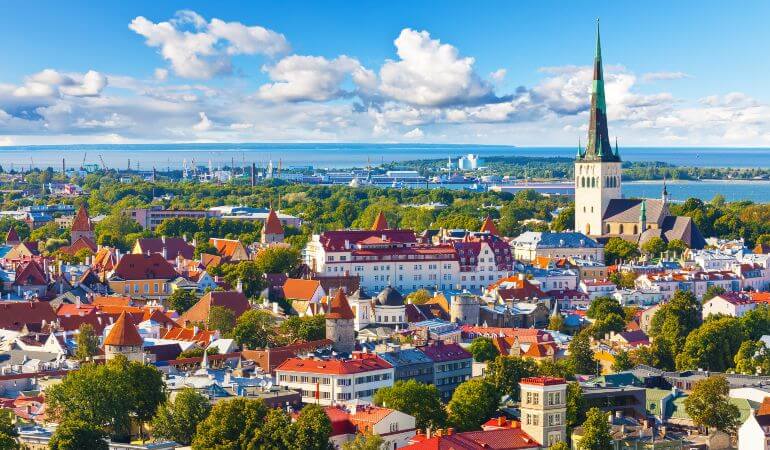
- Capital City: Tallinn
- Population: 1.349 million (2022)
- Official language: Estonian
- Commonly spoken languages: Estonian, Russian and English
- Currency: Euro (€)
Are you considering moving from the UK to Estonia? We don’t blame you!
With over 2000 islands on its territory, тхе Baltic country offers a lot of magnificent views to appreciate and fascinating places to visit. The nation has one of the most rapidly improving economies in Europe and has a steady growth of the Gross Domestic Product.
Estonia is flourishing with both cultural and technological improvements. The state’s officials pay special attention to e-systems, modern education, and online protection; therefore, the country is home to the world’s most advanced digital society.
Keep reading to find out why the number of British citizens who move to Estonia has increased by 11% in a single year.
Table of Contents
Can a British citizen move to Estonia?
To move to Estonia from the UK, British citizens must acquire a residence permit relevant to their purpose of stay. This permit can be extended, and you can eventually apply for permanent residence or citizenship.
However, Estonia has a limit on the number of immigrants. According to it, the total number of applicants who relocate to the country should not surpass 0.1% of the permanent population per year. Yet, there are two exceptions to this regulation: for individuals from the US or Japan or those from other countries who need a residency permit to conduct research or study in Estonia.
If you are considering moving to Estonia from the UK, it’s important to understand the requirements and seek guidance from the Estonian authorities for the most accurate information.
Where to live in Estonia?
Estonia offers a variety of living options, ranging from vibrant urban centres to serene countryside settings. Some of the best places to live in Estonia are:
Tallinn
If you’re moving from the UK to Estonia, there’s a decent possibility that Tallinn will be among your top choices for your new home. It’s the biggest city in the country, and tons of organizations and universities are based there.
As indicated by British expats, Tallinn boasts an outstanding quality of public transport, a great climate and an extraordinary work-life balance. If you live in the capital of Estonia, you’ll enjoy fairly moderate utility and accommodation costs. That’s why it is undoubtedly turning it into a favoured place for international students from all over the world.
Tartu
This is the second-biggest city in Estonia. It has a cultural personality, and it offers a lot, in terms of sightseeing, in case you like museums, art and sacred buildings. A trip from Tallinn to Tartu takes about 2 to 3 hours, so housing and real-estate prices are in the affordable range.
Regarding leisure options, Brits who relocate from the UK to Estonia state that there are few great bars with live music. Tartu’s citizens are free-spirit and easygoing. In any case, the laid-back attitude, so normal among Estonians, is as much on show in Tartu as it is in the rest of the state.
How to get permanent residency in Estonia
To move to Estonia, non-EU/EEA/Swiss citizens need a long-stay visa. It is valid for 1 year and can be used for work, study, retirement, or family reunification. Upon entering the country, they must apply for a temporary residence permit at the Police and Border Guard Bureau.
You should get your residential status registered, in order to receive access to Estonian medical coverage, social help, and numerous other benefits. So, to register your residence address in Estonia, you have to:
- Fill in a residence notice, which is usually in Estonian
- Make a photocopy of your ID
- Provide proof of residence – a rental agreement or a real estate contract
Taking an Estonian language test is a mandatory cond step if you decide to apply for citizenship, once settled for a few years in the country. Studying Estonian isn’t a child’s play, but expats often embark on the journey of learning that beautiful language. Don’t worry though, you gain brisk ground once you handle the nuts and bolts of it.
As a third step, you must take a test on the Estonian constitution and the Citizenship Act. The assessment checks your insight not only of the constitution but also on the fundamental rights, responsibilities and commitments of the residents of Estonia.
Last but not least, you need to apply for citizenship through the Estonian Police and Border Guard Board. Present your application in Estonian when you have passed all the necessary assessments. What’s more, you’ll need to provide:
- Proof of salary pay or means of living
- Proof of state charge payment
- A guarantee that you have cancelled your citizenship of another country or you are in the process of doing it
Be aware that Estonian citizens can’t hold citizenship in another country. As an exception, if you own UK citizenship and you have a child, they can keep both their Estonian and UK citizenship. Yet, that right is no longer applicable once your kid reaches the age of 18.
Working in Estonia
Estonia’s job market offers a variety of opportunities, particularly in the tech and digital sectors. Home to a number of successful startups, such as Skype and TransferWise, the Baltic country is a popular destination for specialists in cybersecurity, IT, and entrepreneurship.
Software developers, digital marketers, and technology researchers are in high demand, and Estonia’s startup culture offers many opportunities for entrepreneurs and people interested in working with emerging technologies. Additionally, Estonia’s E-Residency program provides international entrepreneurs with online access to the country’s business environment, so they can easily start and run a business from anywhere.
Proficiency in the Estonian language is advantageous for integrating into the country and the job market. However, many tech companies and startups operate in English, which facilitates integration for individuals moving from the UK to Estonia for work.
Transportation in Estonia
With frequent light traffic and trustworthy public transport, Estonians enjoy a well-built road network. As a slight disadvantage, venturing outside bigger cities may take longer. Double carriageways are not that common in Estonia, so keep that in mind if you travel outside of Tallinn.
According to expats, the public transport network is prompt and very reliable. Buses, trolleybuses, and trams work from early morning to midnight.
You can get one-time travel tickets directly when onboard in the vehicle. A prepaid travel card is a more cost-efficient choice, and you can buy one in most metropolitan areas. You can use the travel card to get tickets and many rides; just remember to top it up with some cash first.
The inhabitants of Tallinn are lucky enough to get free public transport services; however, there are some requirements.
Going via train in Estonia is cheap and straightforward. For example, an express train from Tallinn to Tartu is about two hours and costs around 10 EUR. During your trips, you can enjoy not only the pleasant views that Estonia offers but also a stable Wi-Fi connection.
Driving your own car in Estonia
You can bring your UK vehicle to Estonia for as long as six months of 12 in total, but make sure to have your:
- Driving licence
- Valid insurance
- Personal ID
- Documents to prove your ownership of the vehicle
Also, to avoid fines and penalties, remember the following set of rules:
- It would be best if you turn your vehicle lights on during all hours of the day
- You must have headlamp beam deflectors, based on the type of vehicle you have
- Don’t forget to carry a first aid kit and a fire extinguisher
- As strange as it seems, drivers in Estonia need to have 2 warning triangles
- Also, you’ll need a couple of wood or plastic blocks to put under your wheels if you’ve parked on steep ground or ice
As a rule of thumb, you can’t park your car on the first free spot you see. Most municipalities offer public parking areas, and if you can’t find a place there, try private car spaces.
Whether you live in Tallinn or Tartu, on-street parking is separated into zones, so try to use an app to see how much it would cost you to leave your car there. You can pay via phone application or an instant message.
Education in Estonia
The structure of Estonia’s educational framework is similar to that in the UK, and it progresses into various stage levels. Everyone starts with preschool training, moves to basic education, then into upper secondary and, lastly, higher education. Children can take part in educational programmes at the age of seven.
As for the financial aspect, related to education, the Ministry of Education and Research covers the overall costs of state schools. To that, municipalities take care of the expenses of local schools, and there are privately funded schools, too.
Being a student in Estonia
Estonian universities invite an ever-increasing number of international students. With some of the highest standards in Europe, the institutions offer degree programmes and shorter courses in English, Russian and Estonian. Curiously, full time higher education in the native language doesn’t cost a penny.
If you are moving to Estonia from the UK, you must know that for the most part, tuition fees for English programmes start around 1 600 EUR and may go as high as 7 500 EUR. And if you plan to study medicine, it can cost you around € 12000 per year.
Healthcare in Estonia
As in most countries, you can have both public and private healthcare in Estonia. Usually covered by the Estonian Health Insurance Fund, you get access to your public healthcare once you have a valid employment contract in the state.
Estonia is considered one of the most social countries in Europe; therefore, the healthcare system is available to everybody. Secured by reliable medical services, all regions are equally treated.
Takeaways
To summarise, there are a great number of Brits who are moving to Estonia from the UK, particularly to work and study. Expats who live there get to appreciate life in a state with economic freedom, where stunning nature and innovation combine and function well together. Regardless of whether you move to Tallinn or another town, the odds are individuals’ neighbourliness will charmingly astound you.
So, if you are already considering relocation from the UK to Estonia, don’t hesitate to get in touch with our moving company. We will be happy to organise your international removals so you can enjoy a smooth transition and start a new chapter of your life in Estonia.
Moving to another country? Count on Fantastic Removals for an easy relocation!
Enter your postcode to view our rates and availability in your area.
For questions about the services we offer visit our main site or you can always call us at 020 3746 0584














